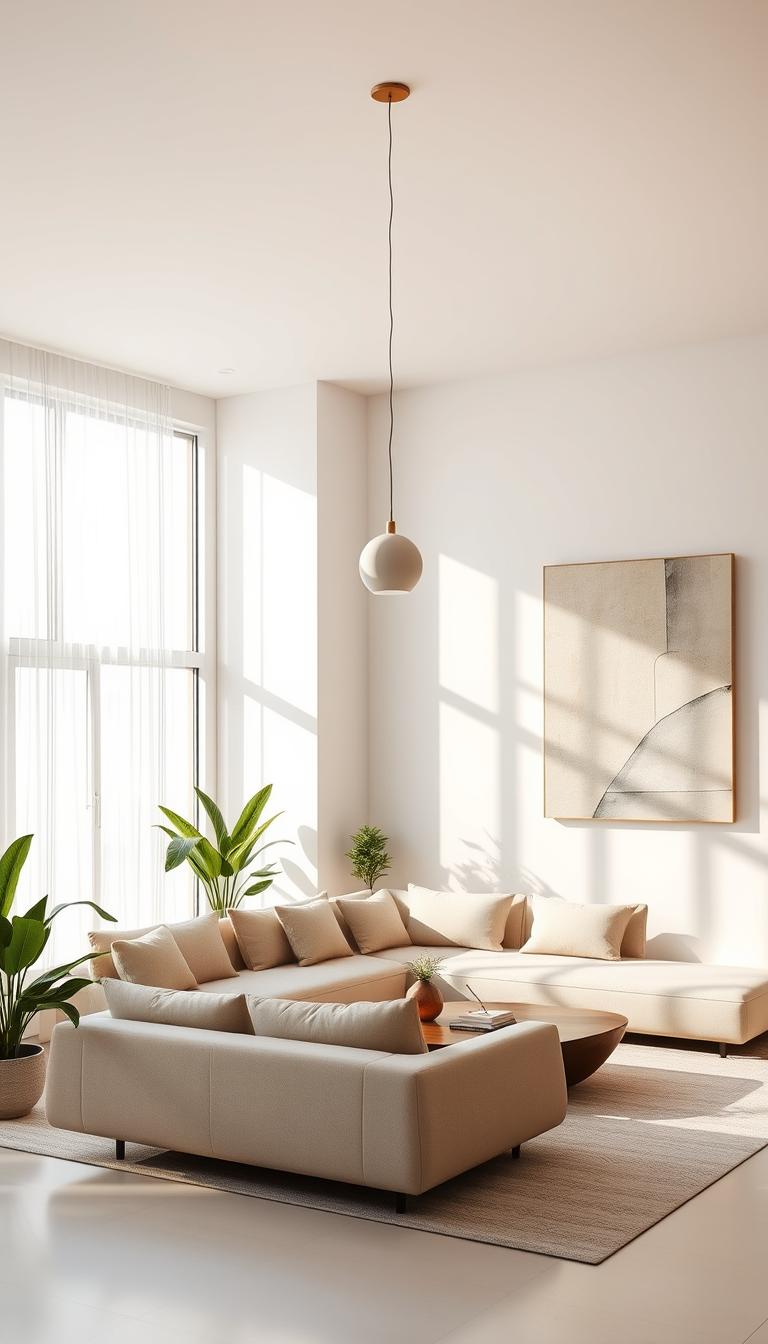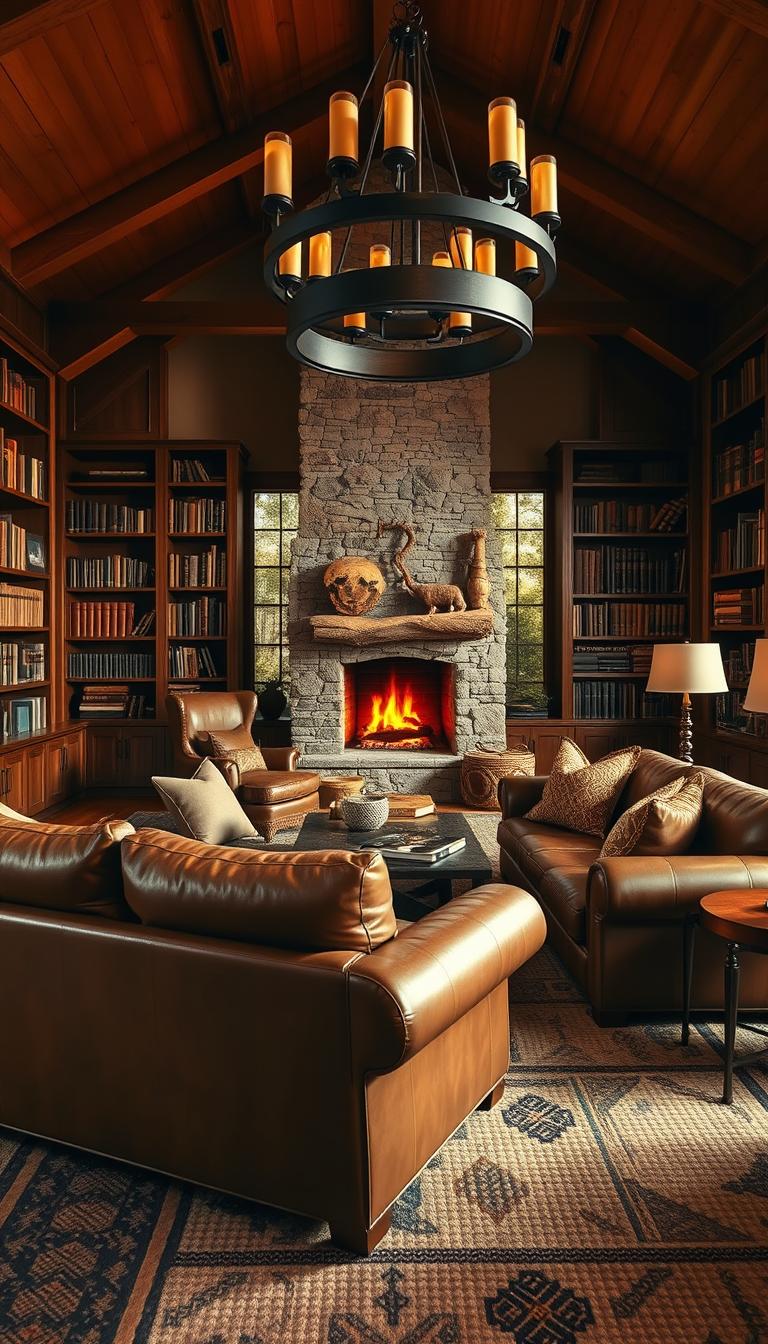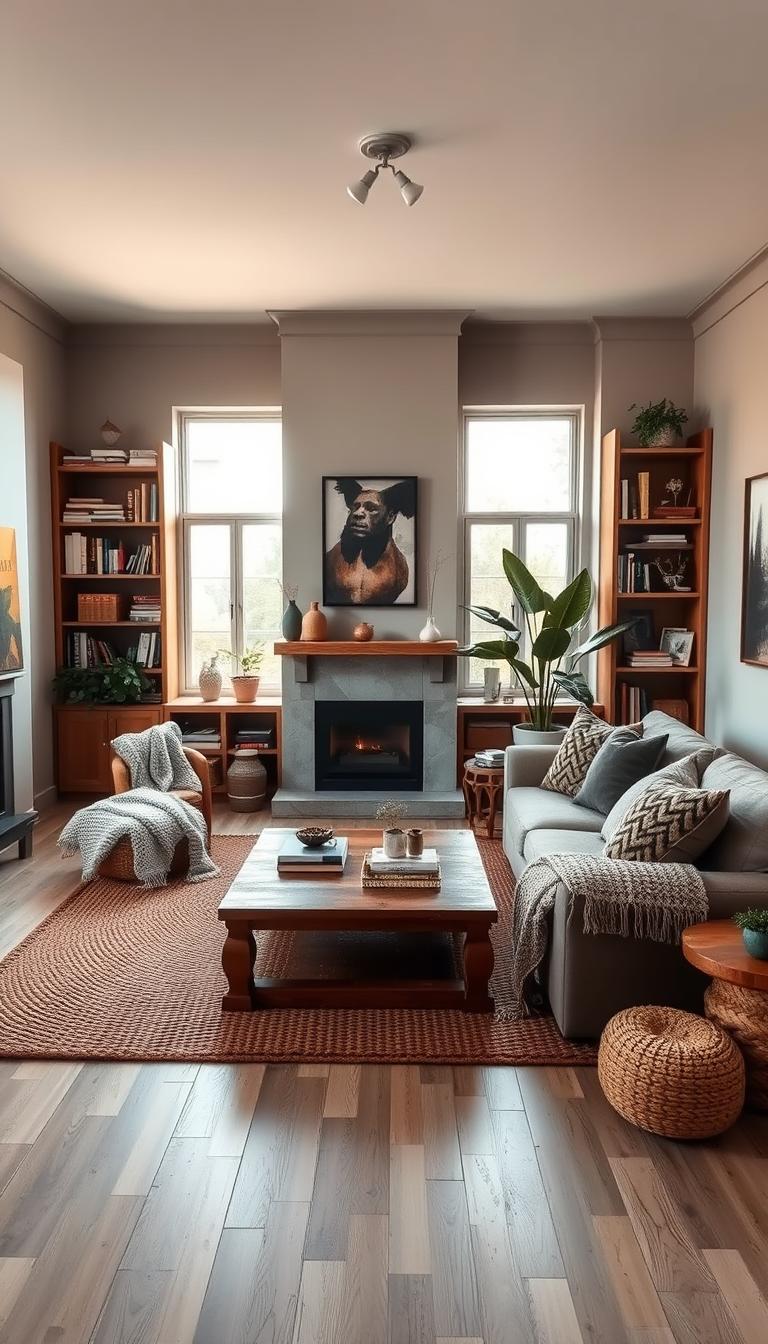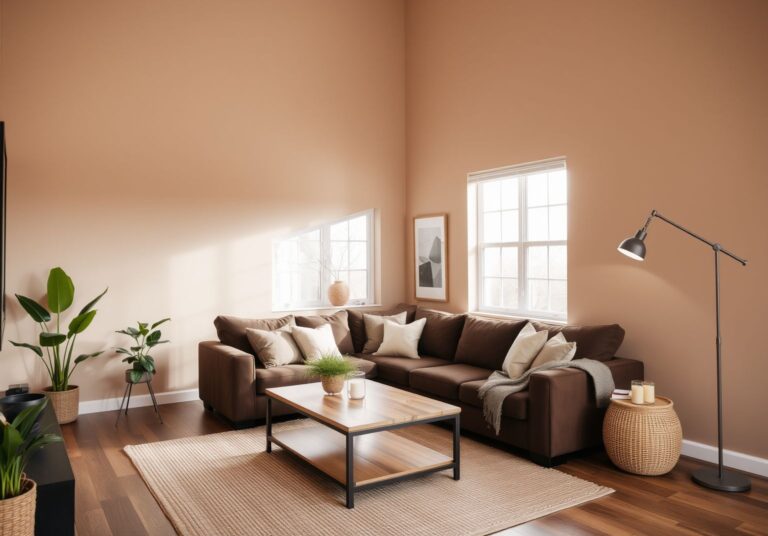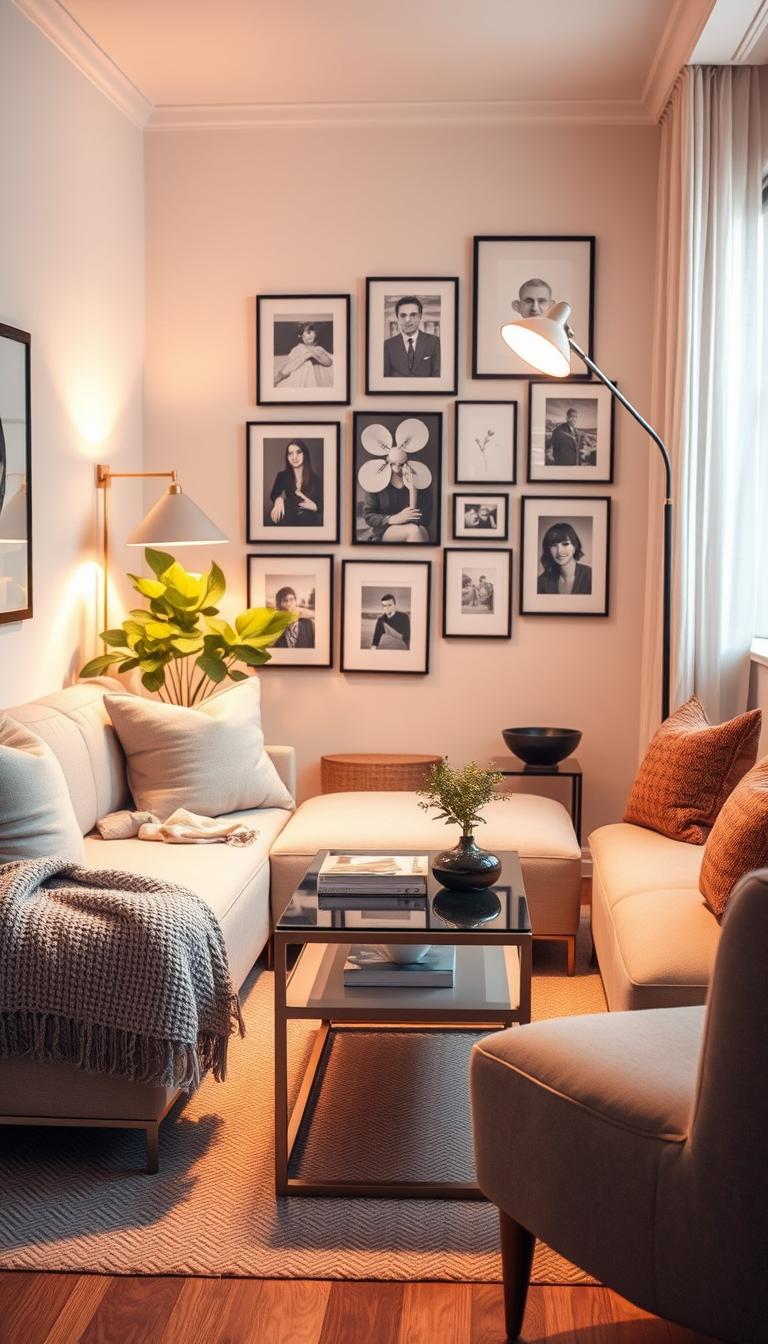15 Stunning Living Room Designs to Elevate Your Home
Your home deserves a space that blends beauty and function. Modern design trends show how thoughtful layouts and bold choices can transform any area. From cozy corners to open-concept elegance, the right approach makes all the difference.
Designers like Minnette Jackson prove that dual seating zones work wonders in long spaces. Samantha Stathis Lynch’s Central Park-inspired sectional shows how statement pieces anchor a room. These examples highlight the power of smart furniture placement.
Current trends focus on balancing aesthetics with everyday comfort. Natural textures, layered lighting, and strategic color palettes create inviting atmospheres. Whether you prefer rich jewel tones or airy neutrals, your space can reflect both style and personality.
Discover how to maximize square footage, define zones, and infuse character. Every detail—from rugs to artwork—plays a role in crafting a cohesive look. Let’s explore fresh ways to reimagine your home’s heart.
15 Stylish Living Room Ideas to Transform Your Space
Dual seating areas bring balance to both large and compact spaces. Designer Minnette Jackson proves this with her clever back-to-back sofa arrangement in a 23-foot-long room. The setup creates intimate zones for different activities without sacrificing style.
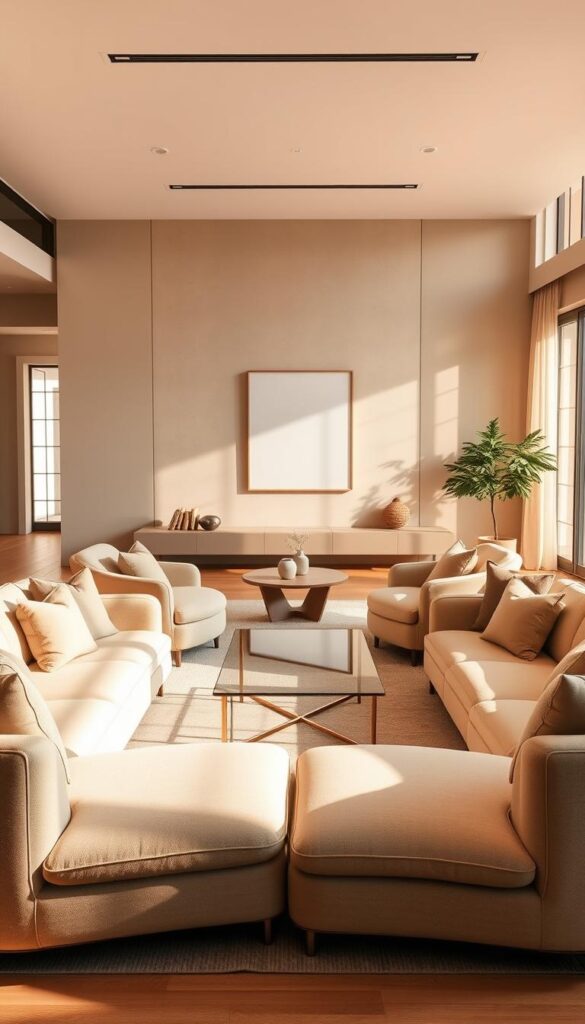
Maximize Layout with Dual Seating Areas
Long or open-plan spaces benefit from divided zones. Try these tips:
- Use modular sofas to define separate conversation areas.
- Anchor each zone with rugs to visually distinguish them.
- Layer lighting—overhead for ambiance, lamps for task lighting.
Keep traffic flow smooth by leaving 3 feet between furniture groups. Mix textures like velvet and linen to add depth.
Choose a Statement Sectional for Impact
Samantha Stathis Lynch’s curved 96-inch sectional shows how bold furniture transforms a room. Its cherry blossom hue became the focal point of a New York apartment.
Consider these when selecting a sectional:
- Modular designs adapt to changing needs.
- Round shapes soften angular rooms.
- Eco-friendly materials align with modern living trends.
For proportions, measure your space first—leave 18 inches between the sofa and coffee table.
Incorporate Playful Furniture for a Dynamic Look
Mandy Cheng’s hanging chair proves fun and elegance coexist. Her Serena & Lily piece blends sophistication with whimsy, creating a focal point in any living room. Suspended seating adds movement and personality to modern spaces.

Balance child-friendly elements with adult aesthetics. Woven rattan paired with velvet upholstery offers texture contrast. Choose durable materials for high-traffic areas.
Safety first: Check weight limits and secure mounts properly. Leave 3 feet of clearance around swinging pieces. For families, opt for reinforced frames.
| Feature | Rattan Hanging Chair | Velvet Hanging Swing |
|---|---|---|
| Style | Bohemian, casual | Luxury, tailored |
| Weight Capacity | 250 lbs | 200 lbs |
| Best For | Sunrooms, patios | Living rooms, dens |
Budget-friendly alternatives include macramé swings or repurposed porch chairs. Layer lighting above hanging furniture to enhance ambiance. In an LA home, a single swing transformed a cramped corner into an airy retreat.
Maintain mixed materials by dusting rattan monthly and spot-cleaning velvet. Rotate cushions to prevent uneven wear. Playful pieces should spark joy—not stress.
Create a Cocoon-Like Atmosphere with Dark Ceilings
Dark ceilings add drama and depth, turning any space into a cozy retreat. Designer Liz Carroll’s 9-foot Pitch Black ceiling paired with botanical wallpaper proves how bold color choices redefine modern design. This technique creates intimacy while making high ceilings feel intentional.
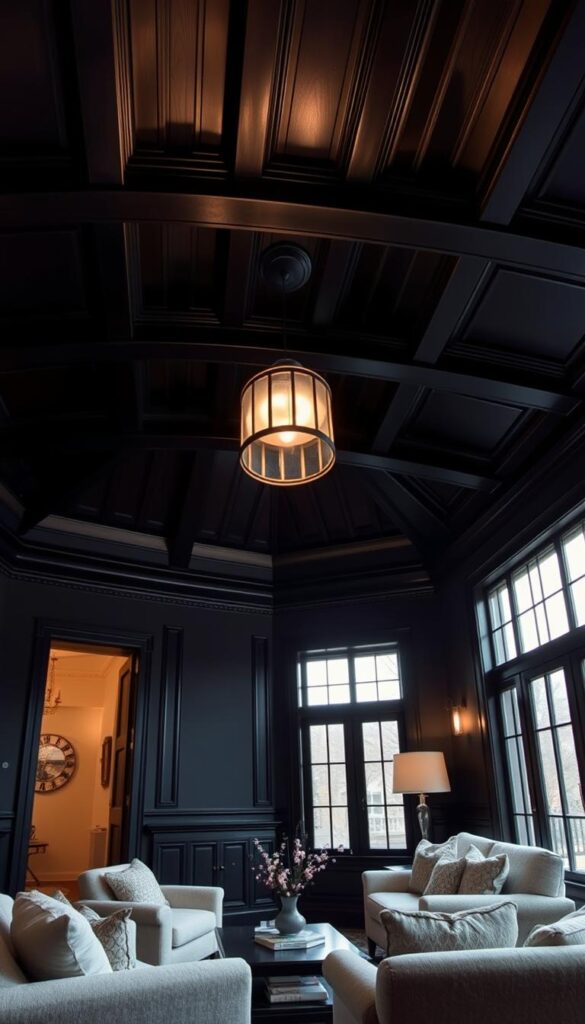
How to Balance Bold Ceiling Colors
Aim for a 70/30 ratio—dark overhead, lighter walls—to avoid overwhelming the room. Hidden LED coves or sconces prevent cave-like effects. For trim, match the ceiling color for seamless transitions.
- Lighting: Layer ambient (overhead) and task (lamps) sources.
- Textures: Matte finishes reduce glare; metallics add reflectivity.
- Humidity: Use vinyl-coated wallpaper in moisture-prone areas.
Pairing Wallpaper with Dark Hues
Botanical or geometric prints pop against deep backdrops. The Boston townhouse case study shows how large-scale patterns prevent a cramped feel. Key elements for success:
- Scale: Oversized prints balance dark ceilings.
- Placement: Use on accent walls to maintain openness.
- Maintenance: Opt for scrubbable finishes in high-traffic zones.
Mirrored furniture or metallic accents bounce light, enhancing the moody vibe without sacrificing brightness. For seasonal adaptability, swap throw pillows or rugs to refresh the palette.
Design with Cohesive Color Palettes
Kobel & Co’s pillow strategy proves small color choices create big impact. Their 3-color rule—dominant, secondary, accent—keeps throw pillow arrangements intentional. For example, navy (60%), cream (30%), and gold (10%) create balance without overwhelm.
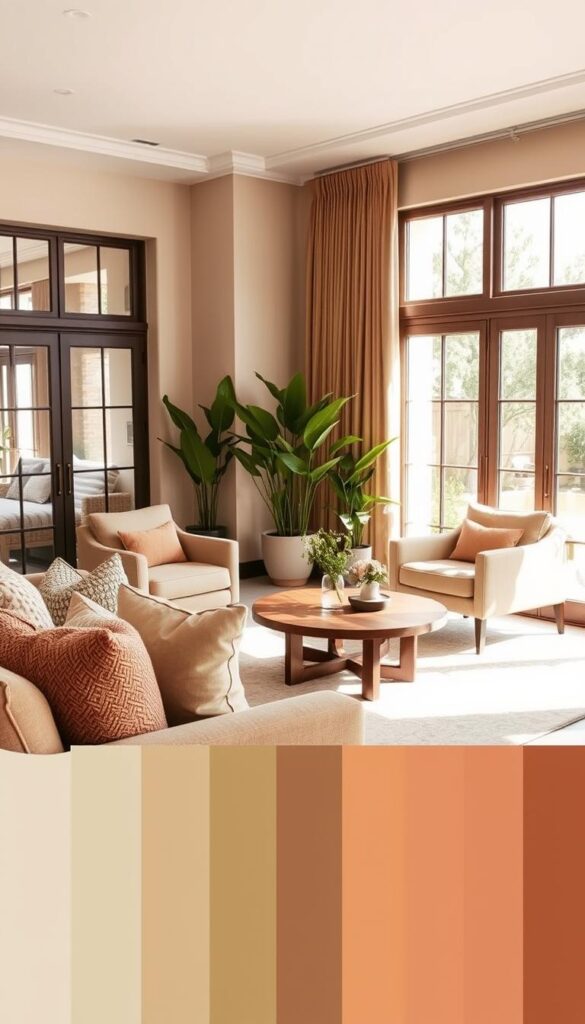
The Whole Home project’s sunset-inspired palette shows nature’s influence. Terracotta walls, peach textiles, and amber glass lamps mimic dusk’s warmth. This approach works because it taps into emotional connections with natural hues.
Psychological effects matter:
- Monochromatic schemes (like all-ivory) feel serene but need texture to avoid flatness.
- Complementary colors (blue/orange) energize but require neutral buffers.
Transition color stories between rooms for flow. An Asheville home aligned drapery stripes with wallpaper’s leaf pattern using shared olive and taupe tones. This tricks the eye into seeing connected spaces.
Budget-friendly updates:
- Swap removable decor like pillow covers seasonally.
- Use area rugs to anchor new palettes without repainting.
Digital tools like Sherwin-Williams’ ColorSnap Visualizer help test color palette options. Upload a room photo to virtually “paint” walls or place furniture. It eliminates guesswork for permanent elements.
Opt for Kid-Proof and Pet-Friendly Materials
Families and pet owners need durable yet stylish solutions for their home. Performance fabrics like Crypton, used by designer Sarah Vaile, resist stains and odors while looking chic. These materials blend practicality with modern aesthetics.

For furniture, consider scratch-resistant woods like acacia or bamboo. They withstand pet claws and toddler toys better than traditional hardwoods. Washable slipcovers, like those from IKEA or Burrow, make cleanup effortless.
Key features to prioritize:
- Non-toxic certifications (Greenguard or OEKO-TEX) for safer materials.
- Indoor-outdoor rugs (like the Chicago duplex’s solution) for heavy traffic areas.
- Modular sectionals with removable cushions for easy cleaning access.
In living spaces, antimicrobial treatments on high-contact surfaces (e.g., coffee tables) reduce germs. Anchor heavy furniture to walls for toddler safety—a simple step often overlooked.
Commercial-grade upholstery, like Room & Board’s Metro Sofa, works in residential space too. Its olefin fabric repels pet hair and spills. Balance durability with style by choosing textured weaves or multi-tone fabrics to hide wear.
Separate Your TV Space for a Cleaner Look
Modern design thrives when technology blends seamlessly with decor. Studio Thomas James’ sliding panel solution hides TVs behind texture-rich walls, creating a polished look. This approach keeps your space clutter-free while maintaining functionality.
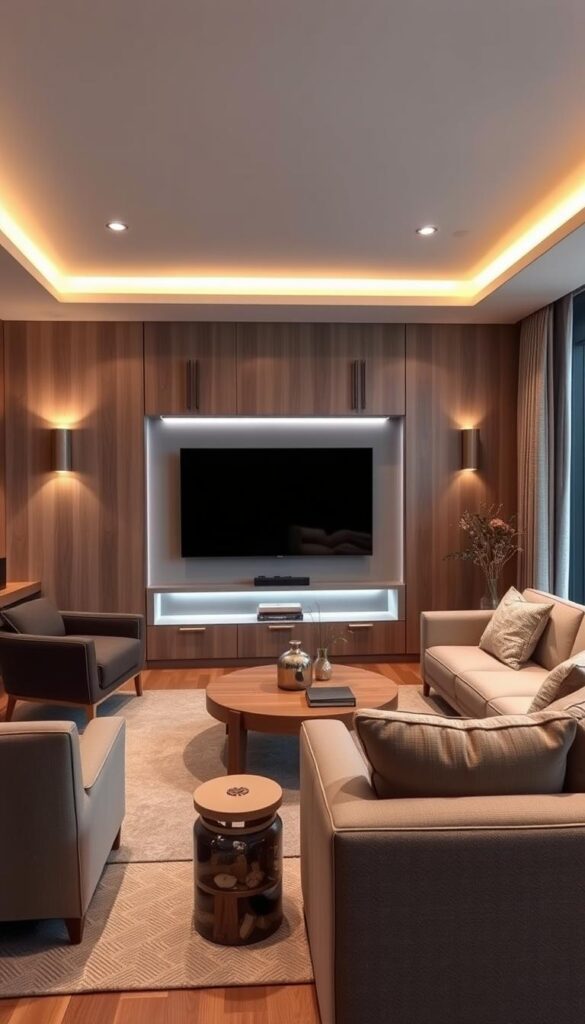
For enclosed media areas, prioritize ventilation and soundproofing. Built-in fans or mesh panels prevent overheating, while acoustic foam absorbs noise. Cable management systems like raceways or in-wall conduits eliminate tangled wires.
Dual-purpose furniture works wonders. A Seattle home’s rotating wall switches between a 65” TV and framed art in seconds. For smaller rooms, credenzas with lift mechanisms save floor space.
| Concealment Method | Best For | Installation Complexity |
|---|---|---|
| Sliding panels | Large walls, custom designs | Moderate (requires tracks) |
| Mirror TVs | Small spaces, modern living | High (professional mounting) |
| Pop-up cabinets | Multi-use elements | Low (furniture-based) |
Lighting control systems enhance home theaters. Dimmable LEDs or smart bulbs adjust for day and night viewing. For safety, secure wall-mounted units with anti-tip brackets and hide cords.
Balance aesthetics with acoustic panels wrapped in fabric. They reduce echo while matching your color scheme. The result? A media zone that feels intentional—not like an afterthought.
Double Up on Coffee Tables for Entertaining
Two coffee tables create twice the function without crowding your space. Kobel & Co’s 48-inch spacing formula ensures each surface remains accessible while maintaining clean sightlines. This approach works especially well in open-concept areas.
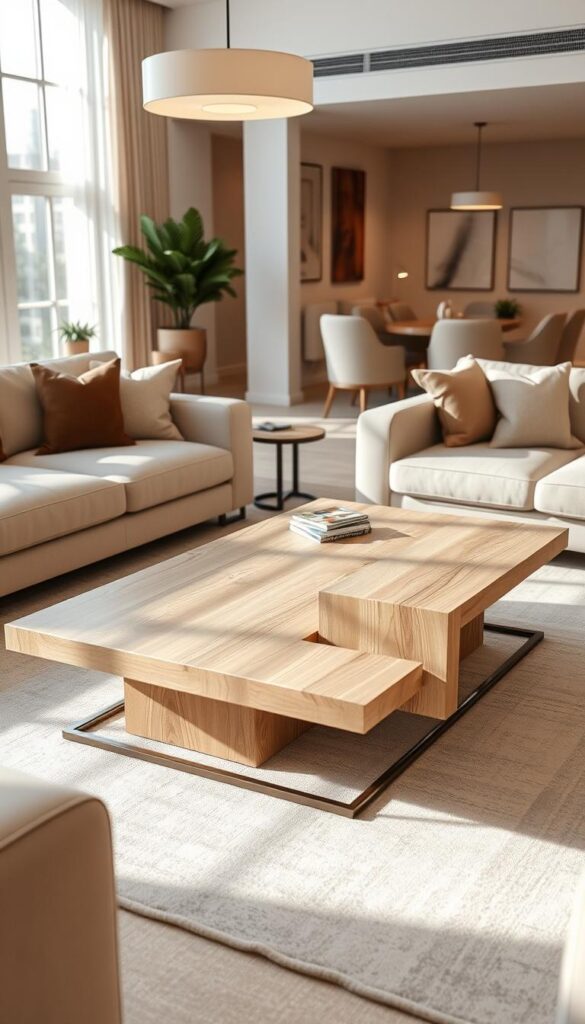
Mix materials for visual contrast. A glass top paired with a wooden base balances modernity and warmth. The Miami penthouse case study shows how marble and brass combinations elevate luxury.
Key considerations for dual setups:
- Nested tables adapt to seating changes—tuck one away when not needed.
- Vary heights by 2-4 inches for layered dimension.
- Non-slip pads prevent glass tops from shifting during use.
Storage-integrated furniture maximizes utility. Drawers or shelves hide remotes and coasters. For heavy tops, check weight limits to avoid sagging.
Optimize traffic flow by leaving 30-inch walkways between tables. Anchoring large rooms becomes effortless with this strategy. The result? A design that’s as practical as it is polished.
Prioritize Conversation with Thoughtful Furniture Arrangement
Great conversations start with smart furniture placement. A strategic layout encourages face-to-face interaction while keeping the space functional. Studio Thomas James’ 72″ circular seating formula proves even compact areas can foster connection.

Symmetrical vs. Asymmetrical Layouts
Symmetrical arrangements suit formal spaces. Opposing sofas or matching chairs create balance. Key rules:
- Center furniture around a focal point (fireplace, artwork).
- Use identical side tables for harmony.
- Anchor with a rug 12–18 inches larger than the seating group.
Asymmetrical designs feel dynamic. Mix furniture heights and styles for casual vibes. The Nashville home’s dual-axis conversation pit used:
- A low sectional paired with armchairs.
- Angled ottomans to guide sightlines.
- Layered lighting (sconces + floor lamps) for face illumination.
Traffic flow matters. Leave 30-inch pathways between seats. For multi-generational seating, include varied chair depths (18″ for kids, 22″ for adults). Acoustic panels hidden behind art improve speech clarity.
Embrace Bold Upholstery for a Focal Point
Make a statement with bold upholstery that commands attention. Winsome Interiors’ 18% pattern scale rule ensures large furniture stays balanced—oversized florals or geometrics won’t overwhelm. This technique turns sofas into art pieces.

Durability matters for high-pile fabrics. Performance textiles like Crypton resist stains, while colorfast treatments prevent sun fading. The Coastal Maine home’s velvet chesterfield proves bold color ages gracefully.
For pet owners: Tight weaves outperform loose knits against claws. Compare options:
| Fabric | Pet Resistance | Maintenance |
|---|---|---|
| Crypton | High (scrub-resistant) | Spot clean |
| Velvet | Medium (hides marks) | Professional steam |
| Indoor-Outdoor | High (non-absorbent) | Hose down |
Reupholstering costs 40% less than custom furniture but takes 6–8 weeks. For unique designs, commission new pieces with 12-week lead times. Blend historical styles—like Art Deco curves—with modern elements.
Pair bold prints with neutral walls. Abstract motifs pop against beige backdrops. Layer complementary throw pillows in analogous hues for cohesion. The result? A space that’s daring yet deliberate.
Monochromatic Magic: Designing with One Color
Monochromatic schemes unlock sophistication through simplicity. Designer Cecilia Casagrande’s navy blueprint uses seven tones—from midnight to powder blue—to craft depth. This approach proves a single color palette can feel dynamic, not flat.

Texture is key in single-color spaces. Combine matte walls with glossy ceramics and nubby linens. The Boston loft case study layered dove-gray flannel, polished concrete, and hammered metal for tactile contrast.
Metallic accents elevate monochrome design. Gold or brass fixtures reflect light, preventing dullness. For smaller rooms, mirrored surfaces amplify natural brightness. Cecilia’s formula reserves 10% of the palette for these reflective elements.
Psychological effects vary by hue. Soft blues promote calm, while deep greens feel restorative. Artwork in analogous shades—like a cobalt painting against navy walls—adds focal points without disrupting harmony.
Historical movements inspire modern style. Bauhaus monochromes used strict geometry, while Victorian-era rooms layered velvet and silk in one hue. Today’s versions balance these traditions with livable minimalism.
Maintenance differs for light/dark schemes. Pale tones show stains but disguise dust. Darker shades require frequent dusting but hide spills. Choose washable decor like performance fabric throw pillows for practicality.
Clever Storage Solutions for Clutter-Free Living
Smart storage transforms cluttered corners into organized oases. Fort Design Studio’s under-table solutions prove even 12-inch clearances can hide essentials. Their modular units tuck into unused space, like sofa legs or bed frames.
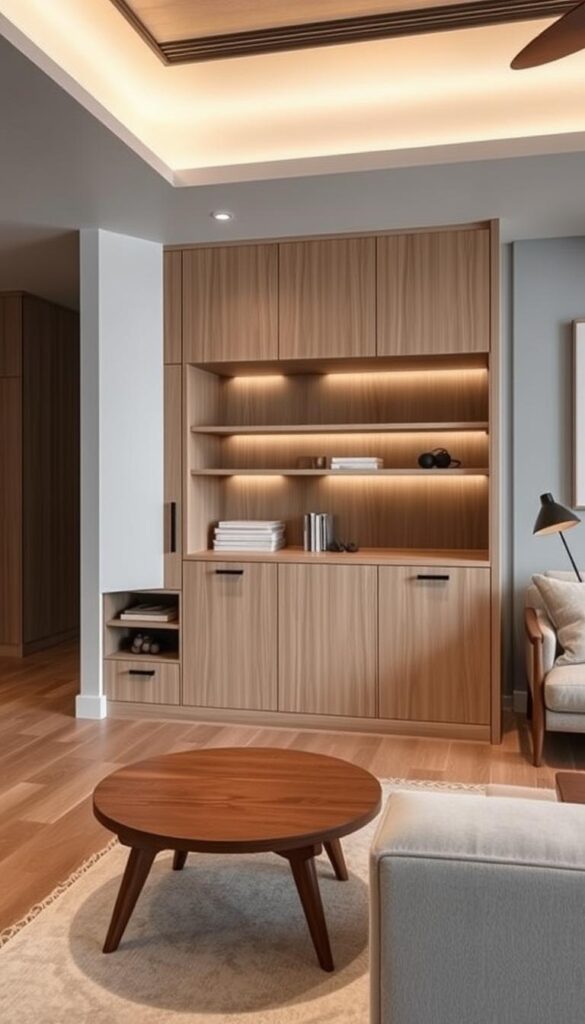
Custom cabinetry offers tailored fits, while off-the-shelf units save time. Compare these options:
- Custom-built: Maximizes odd corners but costs 30% more.
- Prefab: Faster installation with adjustable shelves.
- Hybrid: Mix IKEA frames with custom fronts for budget-friendly design.
Brooklyn’s rotating bookcase wall showcases innovation. It stores 200+ books while doubling as a room divider. For safety, use soft-close hinges and rounded edges on child-height furniture.
Overhead storage needs careful planning. Calculate weight limits (20 lbs/sq ft for drywall). Integrate charging stations inside drawers to hide cords. The key? Make every piece work twice as hard.
Vertical systems like floor-to-ceiling shelves add storage without eating floor space. Use bins or baskets to corral small items. The result? A home that’s as functional as it is beautiful.
Blend Indoor and Outdoor Furniture Styles
Michael Ellison’s swinging couch redefines how we use furniture in any setting. Suspended from aircraft-grade cables (rated for 1,000+ lbs), it merges patio whimsy with living room comfort. This innovation proves style isn’t limited by location.
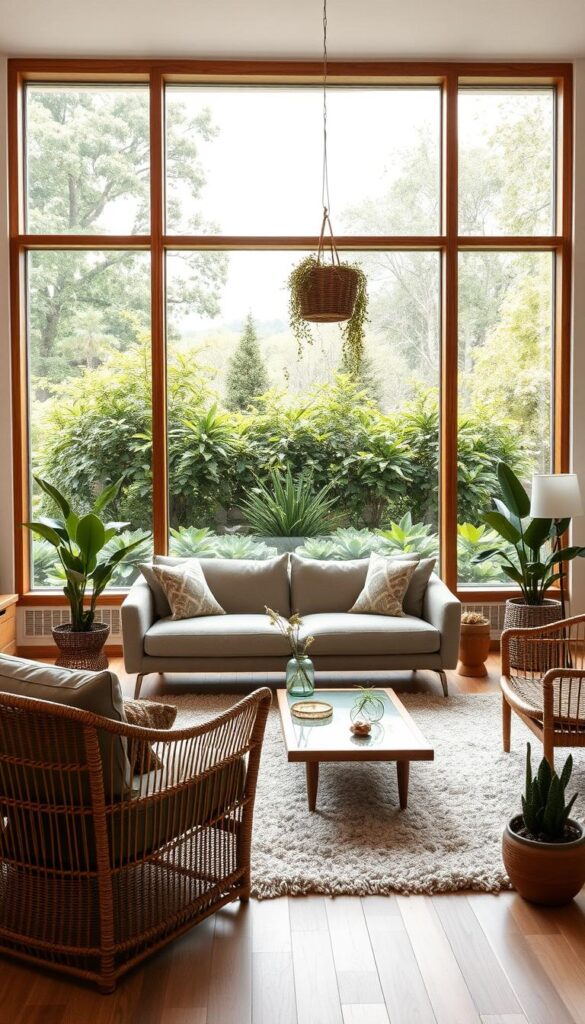
Weather-resistant materials adapt seamlessly for indoor use. Consider these elements:
- Teak: Naturally repels moisture; ages to a soft gray patina.
- All-weather wicker: Lightweight yet durable, with UV-resistant coatings.
- Crypton fabric: Resists stains and fading, ideal for sunrooms.
The Nantucket home’s teak-accented lounge showcases this blend. Its low-profile cushions use mold-resistant cores, while anchor points meet structural codes for safety. Sunlight fade? A quick spray treatment keeps colors vibrant.
For rugs, compare performance metrics:
| Type | Best For | Maintenance |
|---|---|---|
| Polypropylene | High-traffic areas | Hose down |
| Bamboo silk | Formal indoor-outdoor spaces | Spot clean |
Transitional styling means swapping throw pillows seasonally. Opt for natural fibers like jute—just treat them for pest resistance. Warranties matter too: Look for 5+ years on dual-environment furniture.
Mix Patterns Fearlessly for Maximalist Charm
Nick Olsen’s 3:1:1 formula unlocks fearless pattern harmony. His method balances large-scale prints with smaller accents and solids. This ratio prevents visual chaos while celebrating bold design choices.
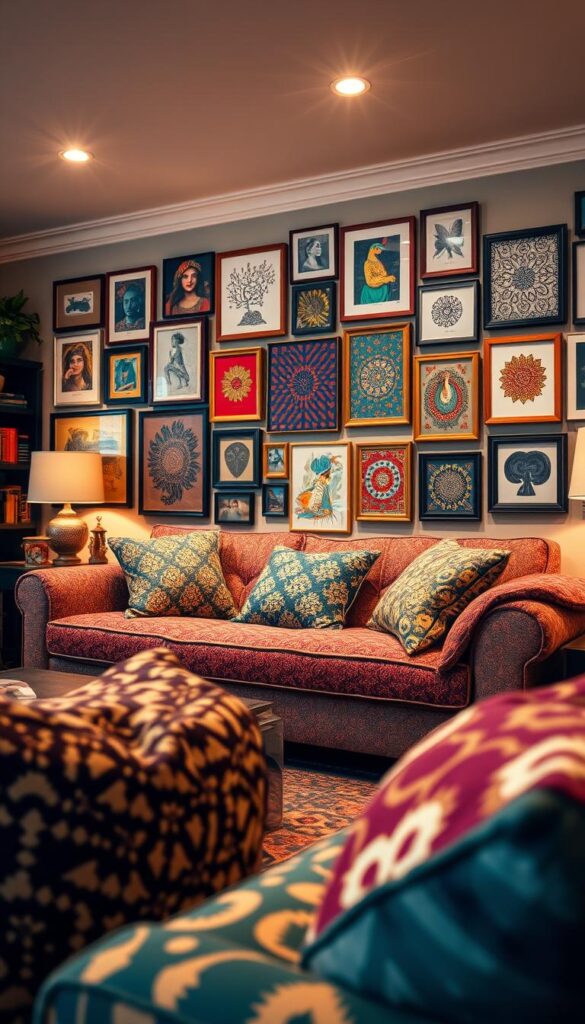
Historical maximalism inspires modern style. Victorian-era rooms layered damask walls with floral chintz. Today’s versions use geometric rugs against botanical wallpapers for fresh contrast.
Scale progression is key:
- Pair oversized florals with petite stripes or dots.
- Use neutral buffers (like beige throws) between busy elements.
- Repeat one color across patterns for cohesion.
An LA bungalow mixed citrus-print curtains with hexagonal tiles. The secret? A shared coral hue tied both patterns together. Digital tools like Spoonflower’s Pattern Playground help test combos virtually.
Lighting alters pattern impact. Daylight softens bold prints, while evening lamps amplify textures. For DIY practice, tape fabric swatches to walls and observe changes throughout the day.
Cultural fusion adds depth. Moroccan zellige tiles pair beautifully with Japanese wave motifs. Stick to a unified palette—indigo and cream—to bridge diverse decor traditions.
Soft Pastels for a Subtle Pop of Color
Historical palaces used pastels long before modern designers rediscovered their charm. Versailles’ powder-blue salons and Victorian mint-green parlors show these hues have always elevated design. Today, Melissa Colgan’s 60-30-10 rule modernizes their application.
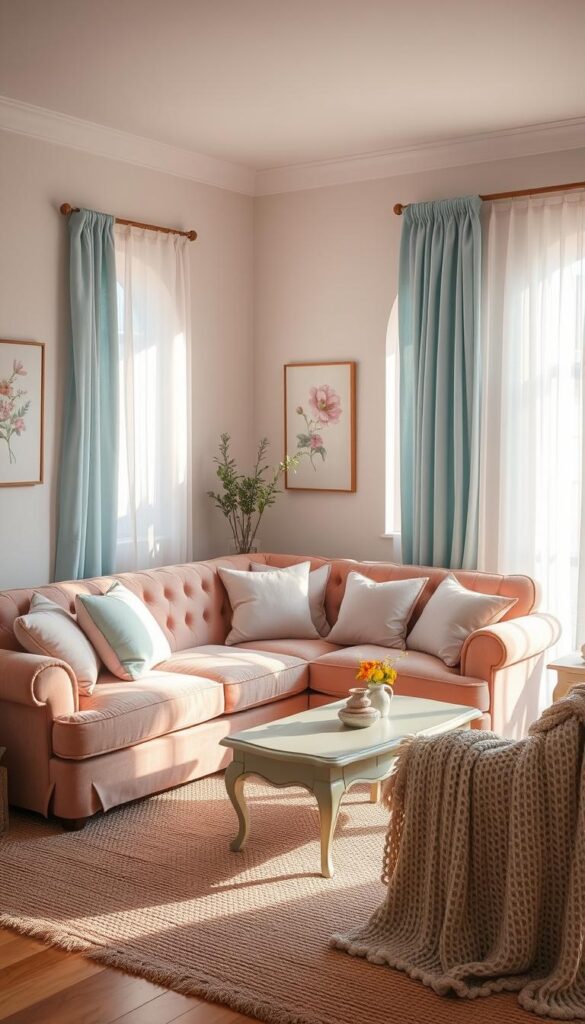
Her formula balances dominant (60%), secondary (30%), and accent (10%) tones. A lavender room might feature:
- Walls in dusky lilac (60%)
- Slipcovered furniture in pearl gray (30%)
- Brass fixtures or plum throw pillows (10%)
Gender-neutral combinations work beautifully. Try sage green with camel leather and nickel finishes. These palettes suit any style, from minimalist to maximalist.
The New England library case study proves pastels’ versatility. Its sage walls paired with:
- Oak bookshelves for warmth
- LED lighting to prevent yellowing
- Acrylic-framed botanical prints
Modern paints resist aging better than historical options. Low-VOC formulas maintain vibrancy for 7+ years. For fabrics, solution-dyed polyester prevents fading from sunlight.
Psychological impacts vary by hue:
| Color | Effect | Best For |
|---|---|---|
| Pale blue | Calms mind | Home offices |
| Muted pink | Encourages warmth | Entryways |
| Light sage | Promotes focus | Reading nooks |
Transition gradually to bold schemes. Layer pastel walls with jewel-toned decor like emerald vases. This creates depth while keeping the base serene.
Metallic accents enhance soft color palettes. Brushed gold drawer pulls or silver-leafed frames add reflection. The key is restraint—limit metallics to 10% of surfaces.
Conclusion: Crafting Your Dream Living Room
Transform your home with confidence using these expert-backed design strategies. From bold upholstery to smart storage, each idea helps create a personalized retreat. Start small—swap throw pillows or rearrange furniture—then build toward bigger changes.
For lasting impact, allocate your budget wisely. Invest in durable furniture first, then add decorative accents. Seasonal updates keep your space feeling fresh without a full overhaul.
Share your progress with design communities for feedback. Need inspiration? Follow interior experts or explore online portfolios. Your perfect living room is within reach—one thoughtful update at a time.
Ready to begin? Snap “before” photos today. In six months, you’ll marvel at the transformation. Happy decorating!
